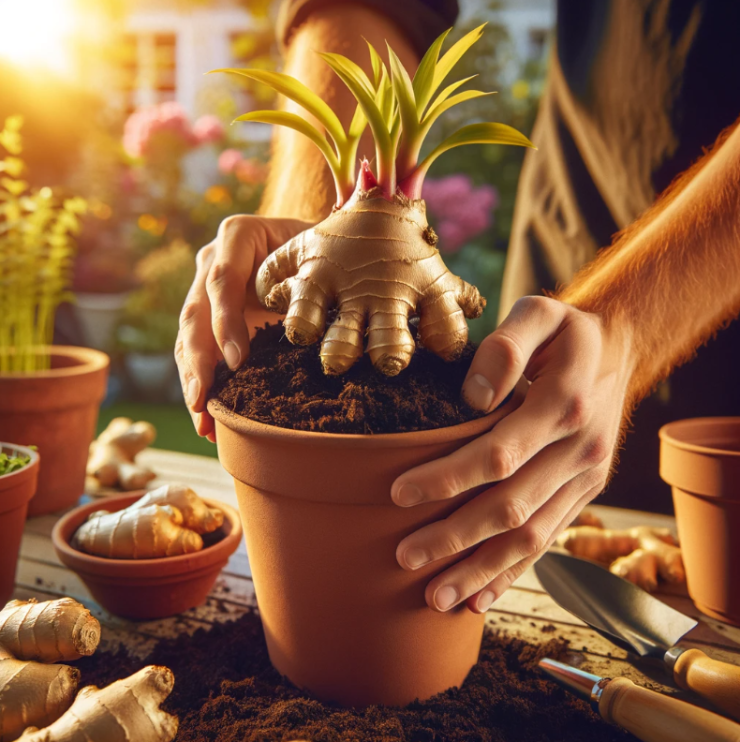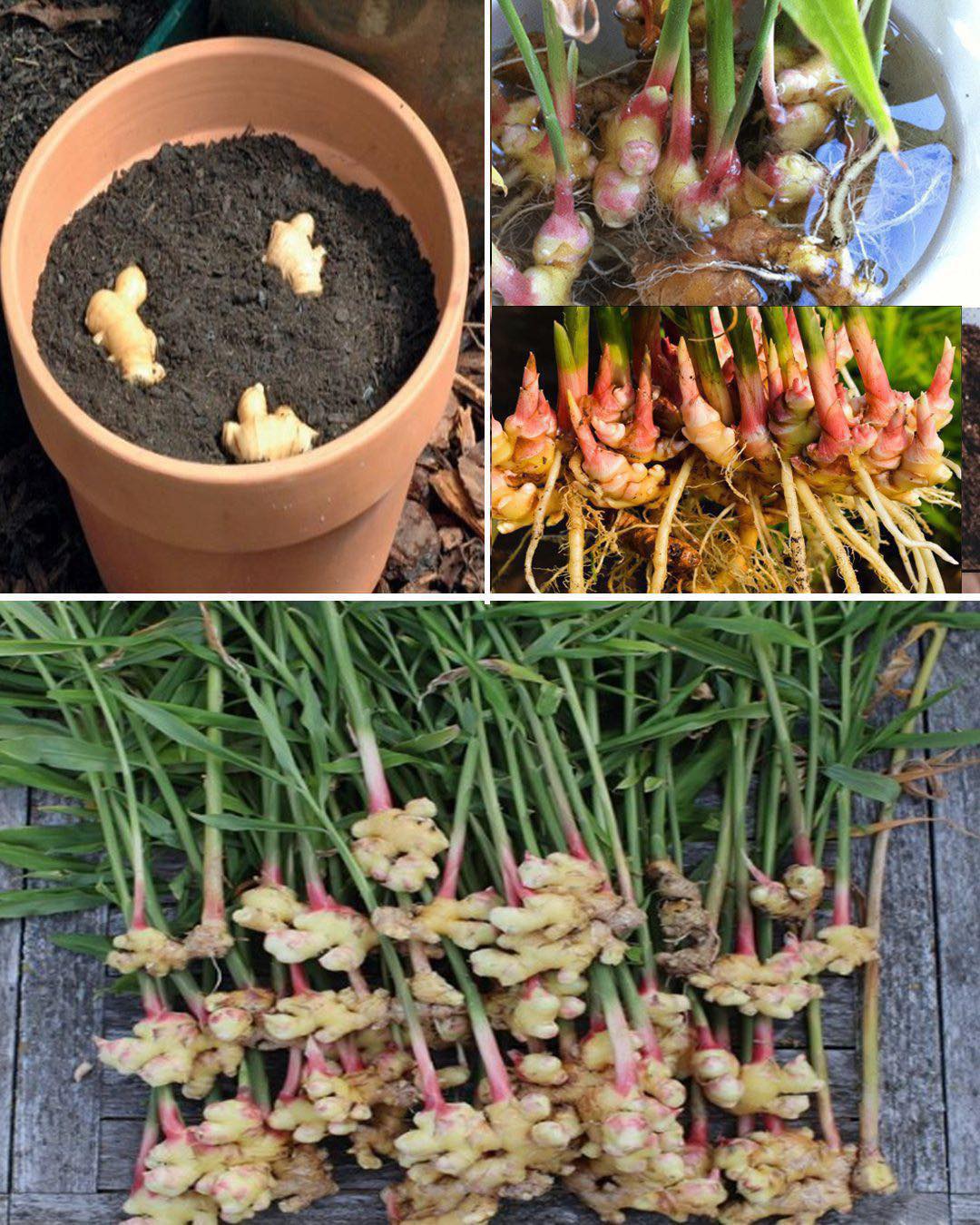Growing your own ginger at home is not only rewarding but also provides you with a steady supply of this versatile and flavorful spice. Whether you have a small balcony, a backyard garden, or just a sunny windowsill, ginger can thrive in a variety of settings. In this article, we’ll share some secrets for successfully planting and cultivating ginger, allowing you to enjoy an endless supply right at home.

Selecting Ginger Rhizomes:
Choose Fresh and Plump Rhizomes: When selecting ginger rhizomes for planting, look for ones that are firm, plump, and free from mold or wrinkles. Fresher rhizomes have a higher chance of sprouting.
Opt for Organic Ginger: Organic ginger is usually a better choice for planting because it’s less likely to have been treated with growth inhibitors or pesticides.
Preparing the Ginger Rhizomes:
Soak the Rhizomes: Before planting, soak the ginger rhizomes in warm water overnight. This helps to break dormancy and encourages sprouting.
Cut the Rhizomes: If your ginger rhizomes are large, you can cut them into smaller pieces, ensuring that each piece has at least one or two buds (small, greenish points where shoots will emerge).
Container Selection:
Choose the Right Size: Ginger doesn’t require a deep container, but it does need a wide one. Select a pot or container that is at least 12 inches (30 cm) in diameter and has good drainage holes.
Use Well-Draining Soil: Ginger prefers well-draining, loose soil. A mix of potting soil and compost works well for container gardening.
Planting Ginger:
Planting Depth: Plant the ginger rhizome pieces with the buds facing upward about 2-4 inches (5-10 cm) deep in the soil.
Spacing: If you’re planting multiple rhizomes, space them about 6-8 inches (15-20 cm) apart to allow room for growth.
Caring for Your Ginger:
Sunlight: Ginger loves indirect sunlight. Place your container in a location where it receives bright but filtered light, or where it gets dappled sunlight throughout the day.
Watering: Keep the soil consistently moist but not waterlogged. Water sparingly during the dormant winter months.
Fertilizing: Ginger benefits from occasional feeding with a balanced, slow-release fertilizer. Apply it every couple of months during the growing season.
Mulching: Adding a layer of mulch around the ginger plants helps retain moisture and regulate soil temperature.
Harvesting Ginger:
Patience is Key: Ginger takes several months to mature. You can start harvesting small, tender rhizomes as early as 3-4 months after planting, but for larger rhizomes, it’s best to wait 8-10 months.

Harvesting: To harvest ginger, gently dig around the rhizomes, being careful not to damage them. Cut off what you need, and replant the remaining rhizomes for future growth.
By following these secrets for planting and caring for ginger, you can enjoy a continuous supply of this delicious spice right at home. Freshly harvested ginger has a vibrant flavor and aroma that can enhance a wide range of culinary dishes, from stir-fries to teas and desserts. So, roll up your sleeves, get your ginger rhizomes ready, and start growing your own ginger plant today. Your taste buds will thank you!
News
JJ Redick reacts to Luka Doncic trade for Anthony Davis
In one of the most jaw-dropping moves of the season, the NBA landscape was rocked by the blockbuster trade involving Luka Dončić and Anthony Davis—a swap that has sent ripples of excitement, disbelief, and heated discussion through the league. Among…
Anthony Davis FULL reaction to trade to Mavericks for Luka Doncic
In a blockbuster move that sent shockwaves through the NBA and left fans reeling, Anthony Davis has been traded to the Dallas Mavericks in exchange for Luka Dončić. In the immediate aftermath of the news, Davis took to the media…
Shaq reacts to Dallas Mavericks wanting Kevin Durant after Luka-AD trade 👀
In the constantly shifting world of the NBA, trade rumors and blockbuster moves are a regular part of the season’s drama. The latest twist has fans buzzing: the Dallas Mavericks have reportedly set their sights on acquiring Kevin Durant in…
Donovan Mitchell FILTHY poster dunk on Kristaps Porzingis 😳
In a game filled with high-intensity moments and jaw-dropping highlights, one play in particular has left fans and analysts buzzing about Donovan Mitchell’s latest display of athleticism. Early in the contest, with the atmosphere already charged by an evenly matched…
Joel Embiid hits go-ahead bucket vs Mavs then chats with Anthony Davis after game
In one of the most thrilling contests of the season, Joel Embiid delivered a clutch performance against the Dallas Mavericks, punctuating the game with a go-ahead bucket that sent the home crowd into a frenzy. The atmosphere in the arena…
D’Angelo Russell game winner as Nets hit two 3’s in 3 seconds to win vs Rockets 😱
In one of the most electrifying moments in recent NBA history, D’Angelo Russell delivered an unforgettable game-winner that left fans and commentators in complete awe. With the Brooklyn Nets locked in a tense battle against the Houston Rockets, the outcome…
End of content
No more pages to load











